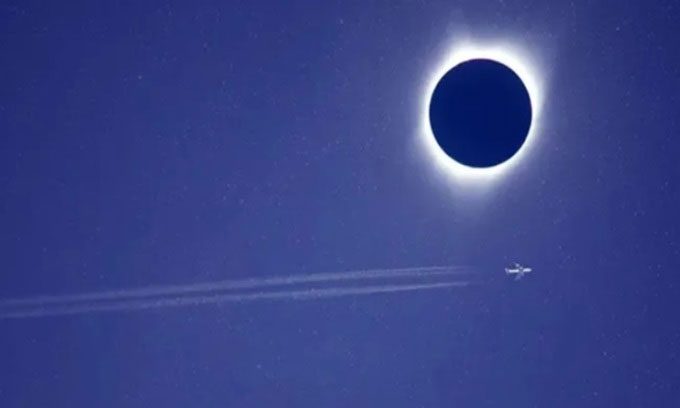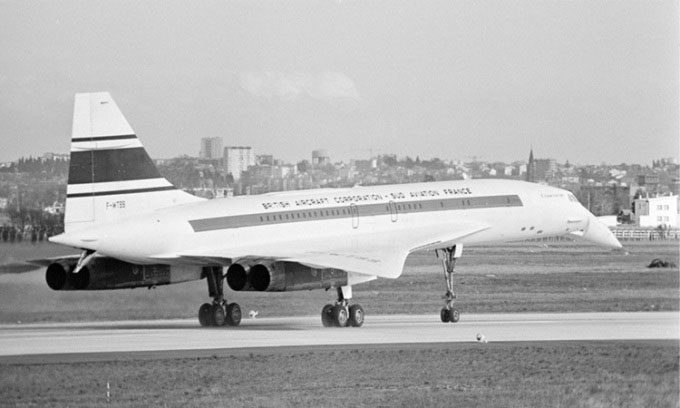In 1973, scientists used the supersonic Concorde aircraft to extend the observation time of a solar eclipse to 74 minutes by flying nearly as fast as the shadow of the Moon moved across the Earth.
On April 8, JSX Airlines had a solar eclipse viewing flight over Dallas, with both United Airlines and Delta selling out their tickets for the flight through the path of totality from Texas to the Northeast. However, no aircraft could match what Concorde 001 accomplished on June 30, 1973, when it chased the shadow of the Moon along the Tropic of Cancer during a total solar eclipse.

The supersonic Concorde chasing the shadow of the Moon in 1973. (Photo: Grant Faint).
Flying at an altitude of 17,000 meters, the world’s fastest supersonic aircraft extended the observation time of the solar eclipse from a maximum of 7 minutes and 4 seconds on the ground to 74 minutes. For the seven observers from France, the UK, and the USA, this was the longest total solar eclipse flight in human history. Although the supersonic aircraft model has long been retired, Concorde’s historic flight in 1973 remains legendary among eclipse enthusiasts.
On June 30, 1973, the Concorde took off from Las Palmas, Gran Canaria, in the Canary Islands of Spain. The path of totality that day was about 251 kilometers wide, with the shadow of the Moon moving at 2,400 km/h. The Concorde flew at a speed of 2,200 km/h (Mach 2) along the path of totality in the same direction as the shadow of the Moon, thereby maximizing the observation time of the eclipse. The extended observation time allowed scientists to study the solar corona and chromosphere, as well as the intensity of sunlight from above the Earth’s atmosphere.

The prototype Concorde 001 made its first flight at Toulouse Airport, France, on March 2, 1969. (Photo: Tony Eyles/Mirrorpix).
The scientists on board were from the Los Alamos National Laboratory, the Paris Observatory, the Kitt Peak Observatory, Queen Mary University London, the University of Aberdeen, and the French National Scientific Research Center. Concorde 001 was specially modified for them, featuring a window on the roof of the aircraft for observation equipment. After takeoff, the Concorde chased the shadow of the Moon over Mauritania. For the next four minutes, it flew over the Sahara in Mali, Nigeria, and Niger before being overtaken by the shadow of the Moon. The aircraft landed in Chad.
The 1973 flight was not the last time the Concorde flew in the shadow of the Moon during a total solar eclipse. Twenty years later, on August 11, 1999, three Concordes, one from France and two from the UK, carried passengers into the shadow of the Moon. Their observation time of the eclipse extended to 4-5 minutes instead of about 2 minutes on the ground. However, passengers had difficulty observing the eclipse for more than 30 seconds due to the small windows and the position of the Sun.
These were the final flights of the Concorde into the path of totality. After the tragic accident of Air France Flight 4590 on July 25, 2000, the solar eclipse flight scheduled for June 21, 2001, was canceled. The most successful solar eclipse flight in recent years was E-Flight 2019-MAX, which took place on July 2, 2019, doubling the observation time from 4 minutes and 32 seconds to 9 minutes.
- The longest total solar eclipse in history is about to occur
- The Moon begins its path of total solar eclipses in 2024
- The Niagara region of Canada declares a state of emergency due to the eclipse
- Why do animals behave differently during a total solar eclipse?
- Why do total solar eclipses occur more frequently in the Northern Hemisphere than the Southern Hemisphere?


















































